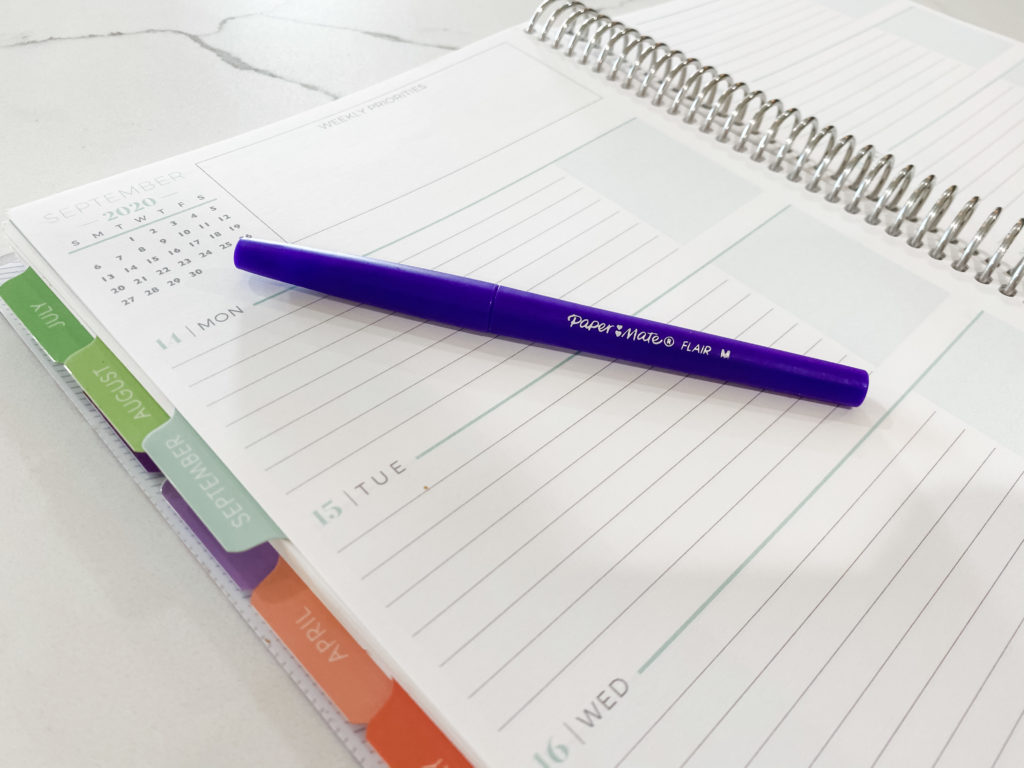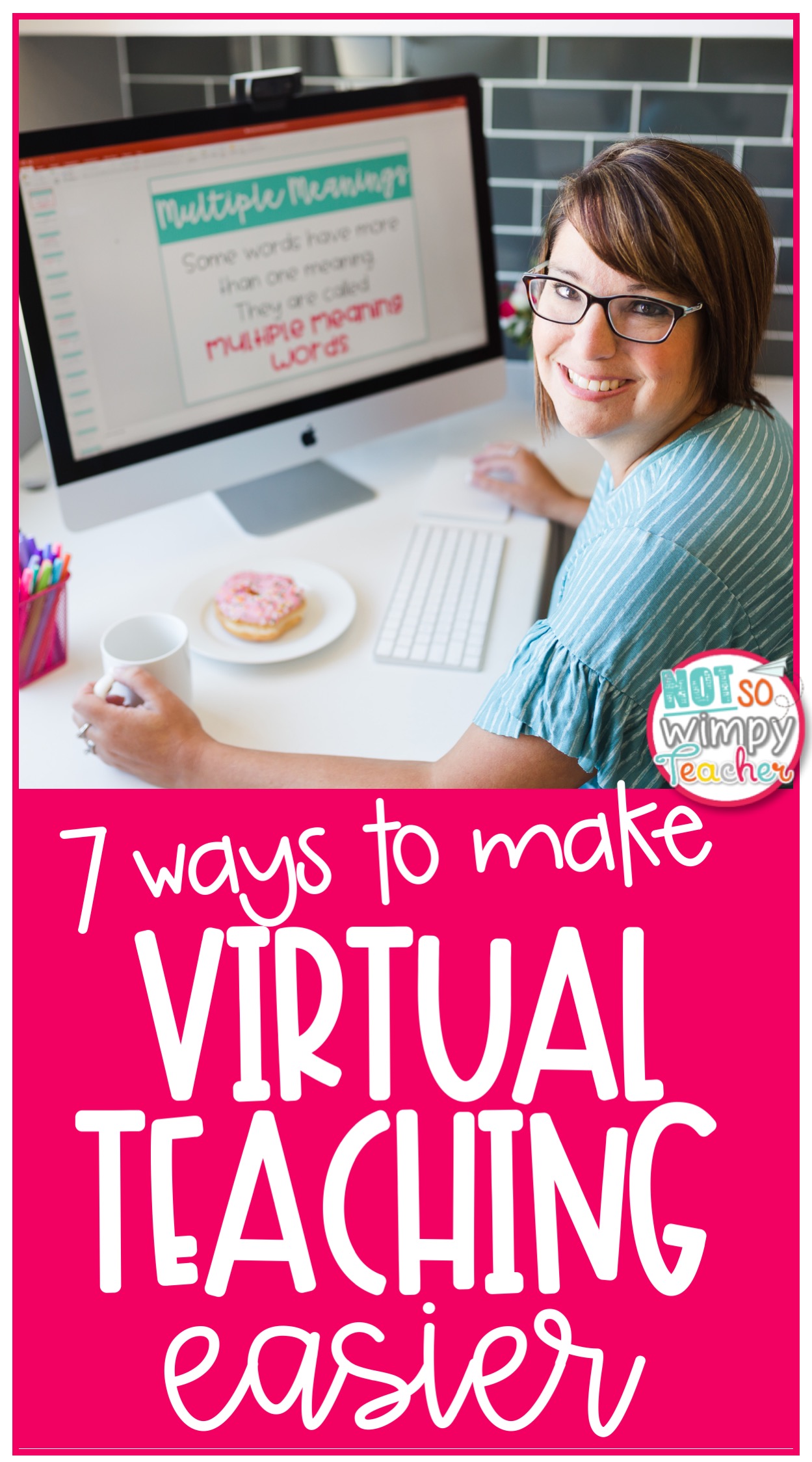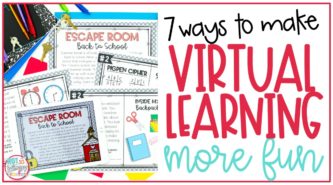
Raise your hand if you feel overwhelmed by virtual teaching. I see you! (Well, mostly I see your posts in my Facebook groups. It would be creepy if I could actually see you right this very moment.) I know that you feel like you are drowning with all of the new technology, strategies, and concerns that come with teaching virtually. I don’t want anyone drowning on my watch and so the Not So Wimpy Team got together and brainstormed some ways to make virtual teaching easier. I can’t make it perfect, but I think these tips will give you the tools you need to make it to dry land.
1. Use Less Technology
I know that you think that I have officially lost it. You are madly trying to learn new technology to make virtual teaching possible and I am suggesting that you use less technology. But stay with me…
You DON’T have to use every website and app out there!
Yes, there are millions of amazing online tools out there. And it probably seems like every other teacher is using them perfectly in their online classroom. But the truth is that less is best!
Why overwhelm yourself, your students, and their families by introducing 10 different websites and another 15 apps? Times are tough for everyone and one of the best gifts that we can give our students right now is to keep things simple.

Instead of trying to do it all, choose 1-3 different online tools that can handle MOST of what you need. (I am a huge fan of Google Classroom and Zoom for online learning!) Spend time teaching students how to use the platform that you have chosen and don’t get distracted by what platform another teacher has chosen.
When, and IF, you and your students are rocking out the original tools that you chose, you can slowly integrate another tool into the mix if you really want to.
But it’s fine if you are not a Flip Gridding, Kahooting, Bitmoji kind of teacher. This does NOT make you wimpy. (And if you have no idea what that last sentence even meant, you are probably my kind of teacher!)
2. Keep to a Daily Schedule
I am about to write something that might make you question our friendship. But it just has to be said…
You DO NOT have to answer every email the very moment that it hits your inbox. (Just as I typed these very words, I heard the ding of my email and ALMOST jumped over to that screen to check it out. This is a hard habit to break!)
But it’s true. Emails can wait. There is no award for the teacher who answers emails the quickest.
The problem with jumping to your inbox the moment that you hear the ding is that you get distracted. You are starting and stopping activities and allowing yourself to go down the cyber rabbit hole. So much time is wasted! And you do not have time to waste!
It’s so important that you create your ideal work and personal schedule. This is different from just creating a to-do list, because you are actually scheduling a time on your calendar to COMPLETE tasks.
Decide when you will answer emails. Decide when you will grade work or respond to comments in your Google Classroom. Decide when you are done with work for the day and keep to the calendar.

It might take a few weeks of reflecting and adjusting the calendar to get it just right, but I promise that this will give you so much more balance!
3. Create Routines
I am guessing you had some routines in place when you were teaching in person. Maybe every Monday you would introduce a new grammar skill and then Tuesday students would complete an interactive notebook activity. Maybe Wednesday students used the grammar skill in writing and so on and so forth.
These routines helped your students to be successful and know the expectations each week. But it also helped you to plan and prep your materials every week.
Don’t forget to incorporate these routines into your virtual classroom.
Are there certain activities that students will do every day? Are there certain things that are always done on Monday? Are assignments very similar every day and turned in the same way each time?
One of the easiest ways to make things more routine is to use year-long digital bundles. Oftentimes bundles give you the same activities for every skill. This will save you loads of time spent searching for new activities every week and explaining the expectations to your students over and over.
4. Batch Lesson Recording
Every time that you record a video for your virtual classroom you have to do at least some of the following:
- move the laundry off the table
- gather your materials
- open up necessary websites or PowerPoints
- comb your hair
- put real clothes on (at least a real shirt)
- throw on some lipstick (if you are an overachiever)
- get up the courage to push the record button
- start over (because you are a perfectionist)
- download the video
- upload the video to Google Classroom
This process can be far too time consuming–especially if you do it daily. The solution? If you are prerecording your videos, do them in batches rather than one at a time.
Maybe Monday is your recording day. Put it on your calendar. Spend time recording ALL of the videos you will need for the week.

You will spend significantly less time recording each week and you only have to wash your hair once per week. It’s really a win-win situation.
5. Assign Less
I am going to tell you a secret…
It is perfectly ok to assign less work in your virtual classroom than you would in your in-person classroom.
It really is!
Families are overwhelmed. Oftentimes they have multiple kids trying to do their virtual lessons and sharing one device. Parents are trying to help their kids to log in to Zoom or Google Classroom while attending a board meeting in their blazer and pajama pants.
Home life stress is real.
So, give yourself permission to assign fewer math problems and less writing prompts. Choose the activities that are the most valuable and save the rest.
If you give a little, students are more likely to do a little. If you give a lot, students get overwhelmed and do nothing or just a little.
Some parents might complain that students don’t have enough to do. But that was always the case with at-home learning too. They just don’t have the same stress and overwhelm as another student in your class. Give them a website such as Moby Max to work on for extra credit. Now everyone is happy!
6. Grade Less
If you are still reading this and you didn’t close the browser after I told you to use less tech and give fewer assignments, then you are ready for me to drop the next bomb…
You really shouldn’t be grading everything!

You can’t read every word and check every problem that your students have completed. And it really isn’t necessary.
Here are some tips for grading:
- Give the fewest grades required by your admin. This is no time to be superwoman.
- Give completion and participation points for some assignments.
- It’s ok to give some multiple choice assessments and quick exit tickets.
- Use self-checking Google Form assessments when possible.
- Toss some assignments into the computer trash can. No one will care or notice.
- Schedule specific times on your calendar for grading. Write exactly what assignment you will be grading and get it done in the time you set aside.
7. Give Yourself Grace
You aren’t perfect and your virtual classroom won’t be perfect either.
A student might get behind. A parent might get upset. Your tech WILL leave you high and dry at least once per week.
But, you aren’t wimpy!
You are growing as an educator every single day. Focus on just how far you have come rather than the bumps in the road. (The bumps actually helped you to learn something new even if it hurt in the moment.)
You have learned to use all kinds of new technology. You have created relationships and culture with a group of kids you’ve never met in person. You have faced your fear of being on video. And you love your class fiercely.
As far as I am concerned, you are highly proficient! (And I can sign that observation form if you need me to.)
Teaching virtually is a challenge, but you are NOT going to drown! Instead, ask yourself, “How am I going to make this easier for myself and my students?” You made long division easier–so I know you can do this too!

Have a Not So Wimpy day,



















 End of Year Carnival Week for grades 2-5!
End of Year Carnival Week for grades 2-5!
I’m finding that having you as a guest teacher for narrative and informational writing is a HUGE help for digital teaching!
Love your post!! Definitely will do what you suggest to make my work easier! Thank you!!!!!
Very good tips! And you made me laugh (you always do) and feel better!
Are you planning do more 4th grade level ELAR activities/bundles?
Thank you Jamie! I needed to hear this. I’m finding myself grading everything and last Friday I realized that I had reached my limit! I appreciate this post and will pass it on!?
Thank you Jamie! That was exactly what I needed to read on this Monday afternoon after spending countless hours last night preparing lessons for this week! Some of your ideas were part of my co-workers discussion last week, but it feels great to feel validated in my feelings!
This is so spot on! I have created relationships where I thought it would be impossible, and I LOVE this class!
Thank you for being there to build us up! 100% virtual can be tough, but we’ve got this!
Thank you for the helpful advice and support! It felt like a pat on the back for the effort I am making and permission to make a few changes in my expectations also.
Do you have a list of virtual online platforms people are enjoying?
For instance:
Review Games: Kahoot, Quizizz and Quizlet
Favorite Self-Grading Platforms: Google Forms, Testmoz.com and again Quizizz.com
Many of the online games will allow you to print a spread sheet showing results.
I would love to hear what others are using.
I thoroughly enjoy my Google Classroom.
Our school is using Seesaw but I am not a fan of how to grade activities.
It is so time consuming.
If you open an activity to edit and write on ( put a star on a paper for an A+ or to correct it with text boxes, when you finish it and close it…. you lose your place and end up looking/searching for the activity again. I am not a fan. So now, if I am grading a Seesaw activity, I give them a grade and maybe comment on what number they missed. Grrrr.
Our school security monitoring program is blocking any youtube formats. We cannot safely share a youtube video at all. The school equipment/chromebooks will block youtube anything: safeyoutube or safeshare.tv
We are desperately looking for safe teaching videos for kids.
We are open to ideas.
We have screencastify and you can record the youtube videos there, but the quality goes down substantially.
Thank you for your support.
I needed to read this today. Thank you❤️
This was really helpful and I love your humor, Jami!! I grade everything that moves so that is the area I really need to work on! I caught myself wanting to compare my colleague’s beautiful reading slides to my very bland ones. I know the time it took her to do all that work (and it was much more than what we had ever done in person) and she is wearing herself out. I’d like to encourage all you fabulous teachers to not fall into the comparison trap. The kids don’t really care, they just love being your students!
These tips are great, thank you for this! One of the things I need to work on is sticking to that routine of when to check emails, do those daily tasks I am responsible for — not to mention to find time for myself. And, oh man, do we all need to give ourselves grace! But you need to be careful with the “assigning” less idea. Where I teach, in the San Francisco Bay Area, we have state (and district) mandated guidelines on “instructional minutes”. Our district has a very clear schedule set up for group meets, small groups, and asynchronous time for grades Transitional Kindergarten to 8. We also have a high population of English Language Learners, and we are required to instruct them in small groups AND assign them to an online platform each three times a week. “Parents are overwhelmed” was last spring: now we keep hearing that we need to have “robust” instruction this year. Teachers in some schools in my district are being told to turn their lesson plans into their principals every week. (My principal has said he’s not standing behind us with a clipboard, thank goodness. But some principals in my district do!) This not a knock on your post, it’s awesome. I am just asking you to be aware that some of us really can’t decide “how much” we assign. What we can do is make the assignments as meaningful as we can and try to give them some activities that are hands-on, not just worksheets or tech-based tasks.
My favorite takeaway from this was “This is no time to be superwoman!” So true! We can only do what we can do! Thank you for your uplifting words of wisdom! I always find something helpful on here:-))